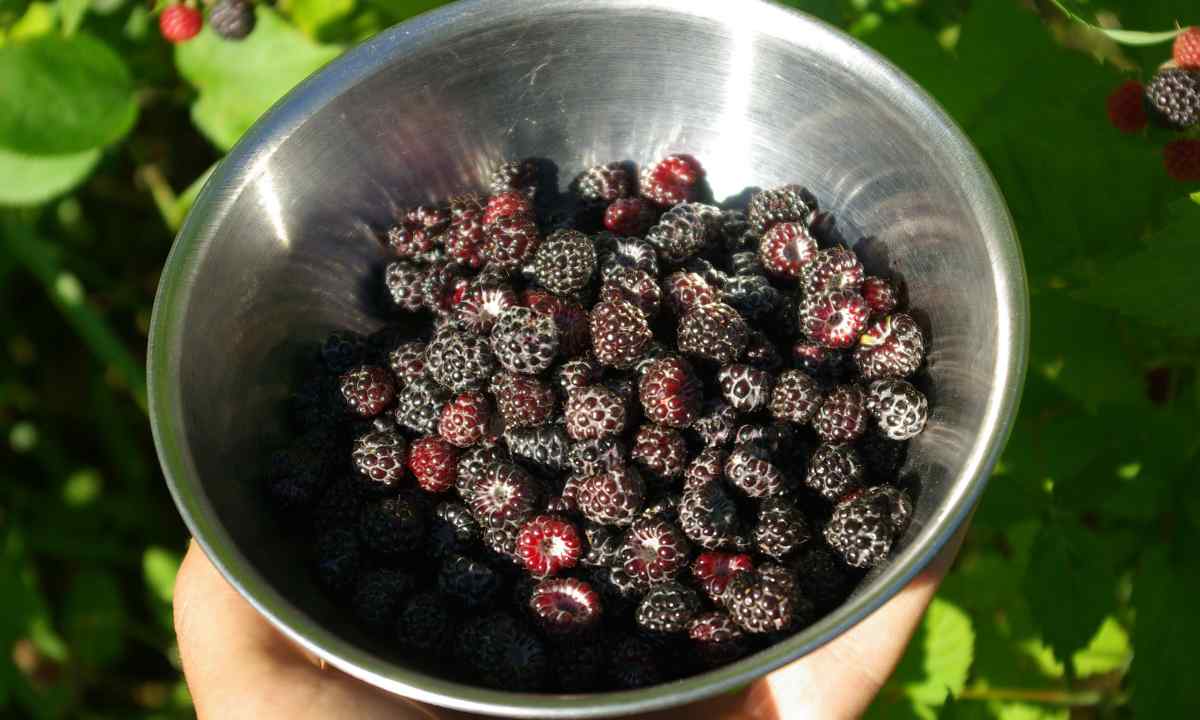Unusual, large, sweet raspberry of coal color. The true exotic – grade Kumberland. The semi-bush is hardy and resistant to set of factors. 20 years without change can fructify. Seldom meets on sale. Kumberland sometimes take for blackberry, but the taste of raspberry a bit different and the size is much more compact.
Raspberry smells delicious and has more sweet, sugar taste, than at burgundy grade. Still Kumberland raspberry appreciate zz long safety and resistance to diseases and mushrooms of mold.
Hostesses during preparations with pleasure add some berry both to compotes, and to jams for taste and beauty, including mixing raspberry to red berries.
As looks
Bushes Kumberland – magnificent, strong, up to 3 m high. Sprawling. In the first year the shoots are allocated with glaucous-green color, two-year-olds already have brown escapes with burgundy shade.
Advantages
- Berries have the average size and equal round shape. While ripen, they remain bright red color, but in the sun darken and to full maturing become is delightful coal color.
- Kumberland of vysokourozhayn and plodonosna (up to 18-20 years). At decrease in productivity the adult escapes should be rooted out and replaced with fresh saplings.
- Berry closer by fall blossoms, but it is very long. At the correct leaving from each branch collect up to 10 brushes by about ten fruits. If to regret young escapes and to allow them to expand up to 10 pieces and more, then fruits crush.
- Black Kumberland does not interest insects at all. Most likely, the reason in black "not berry" color of fruits.
- Blossoms for the second year after landing as there will pass spring frosts. It raspberry saves the fruits from podmerzaniye.
- Raspberry is well pollinated by bees, is unsurpassed melliferous herb.
Shortcomings
- Bushes quickly find thickness.
- Roots quickly expand and give large number of shoots that demands regular thinning.
- Berries tasty and fragrant, but have set of obvious large stones (unlike average red raspberry).
- Escapes have large number of sharp thorns (that at rooting out brings strong discomfort, even in garden gloves).
Landing of raspberry
- It is better to land on forest soils or slabosuglinisty chernozem. Well takes root when landing in the early spring, right after snow descent. Raspberry prefers solar, but windless places. The favourite neighbor in view of good repollination – blackberry. Well grows after grubbing of red raspberry and on lands where before fruitful vegetable cultures grew.
- Distance which should be observed when landing young escapes – from 1 to 1.5 meters. Is possible more. Then there will be no shadowing and degeneration of berries. Very long escapes need support of lane.
- To bury root at 30–40 cm, to do pole diameters in 50 cm.
- Of course, the soil before landing needs fertilizing by torfonavozny compost or humus, sulfate of potassium and superphosphate (proportions are specified on packs with fertilizers). It is possible to add the sifted wood ashes (one blade on hole).
- At first the plant needs abundant watering – on 4-5 liters on bush.
- In year all stalks of this tall grade surely should be tied up.
- Black-fruited raspberry very easy way – rooting verkhushekh breeds (however, both seeds, and layers of escapes too, but it is more labor-consuming). Tops at already long escapes hang down in the top to the earth. They can be hilled prime quality land in August and to condense. In September, small escapes will already appear.
Leaving
Leaving means not only watering 1-2 times a week, but also spring garter of escapes. If the bush has sick, dry escapes – it is better to replace it with new.
It is impossible to allow stagnation and spillover of water during emergence of new ovaries and fructification.
It is recommended to feed up plants after harvesting and also to dilute the sour soil with the sifted wood ashes.
That in the winter raspberry has well remained, it needs to be removed from garter and to bend down to the earth. It is not required to cover it, it is frost-resistant crop. Gardeners use the special brackets which are well supporting escapes.

